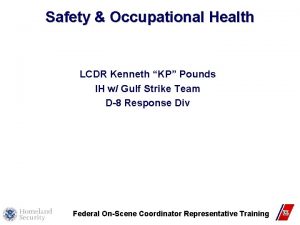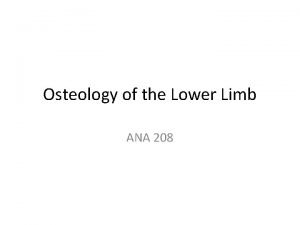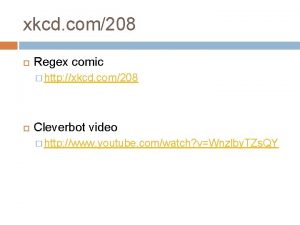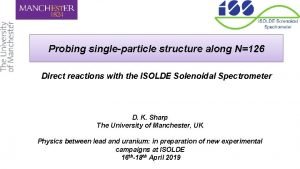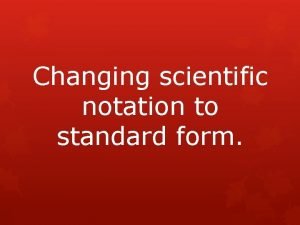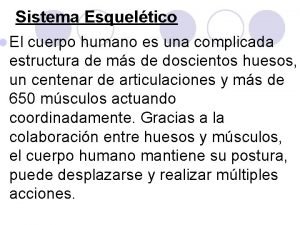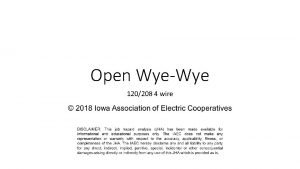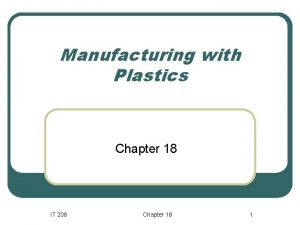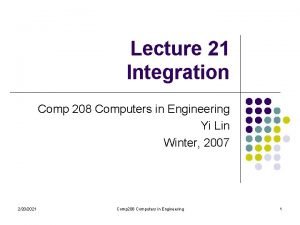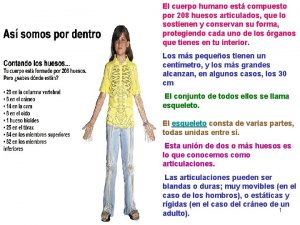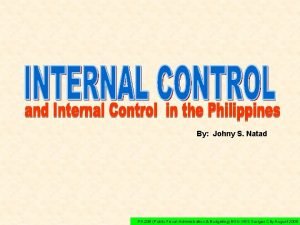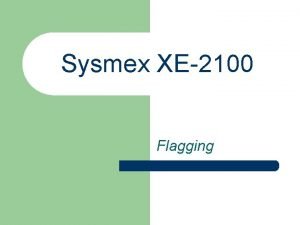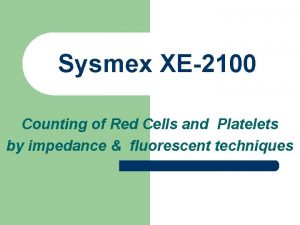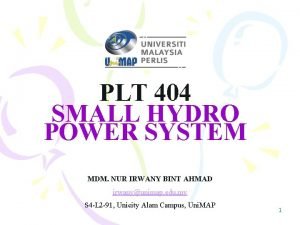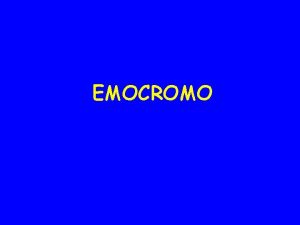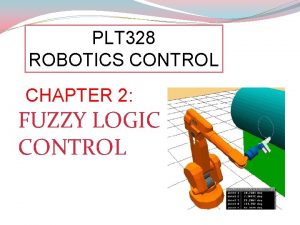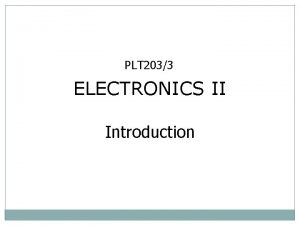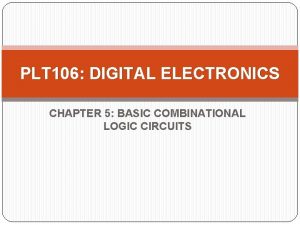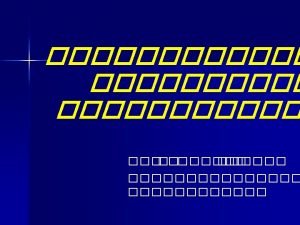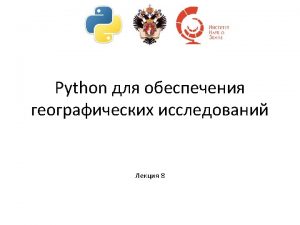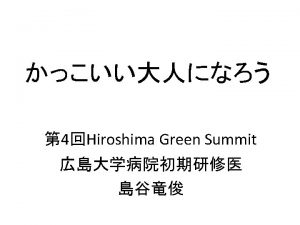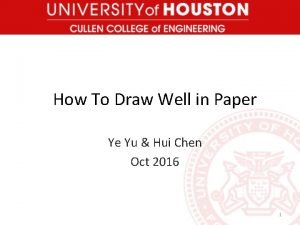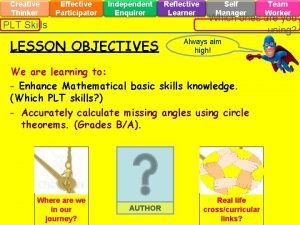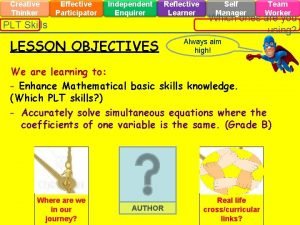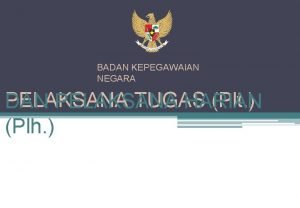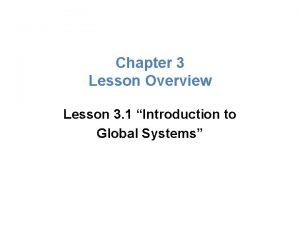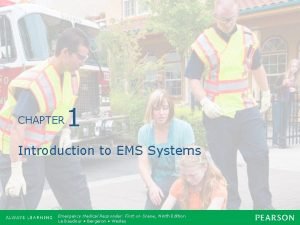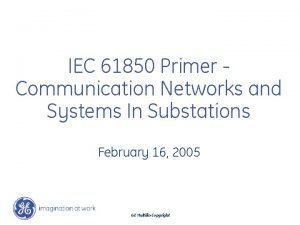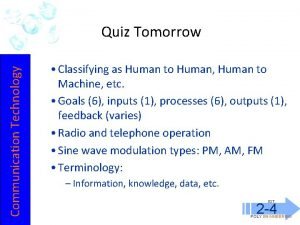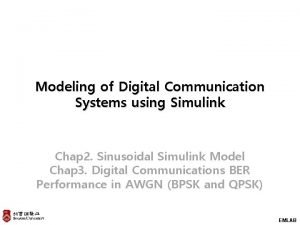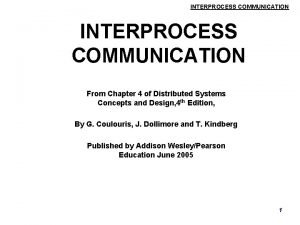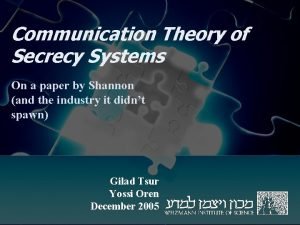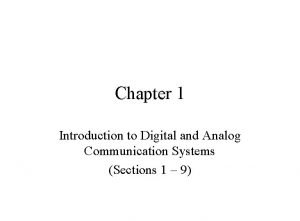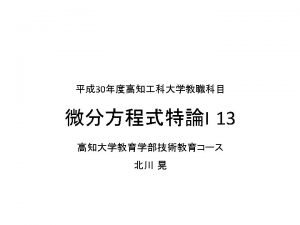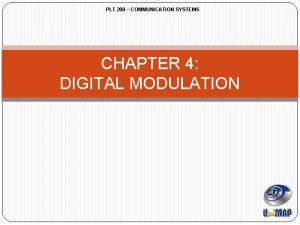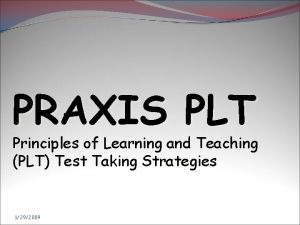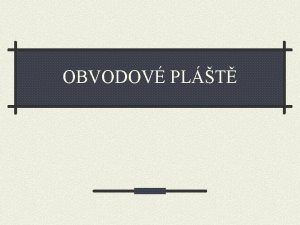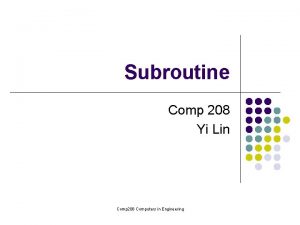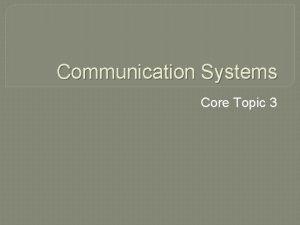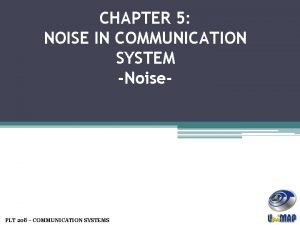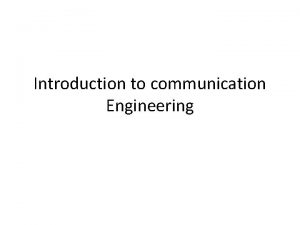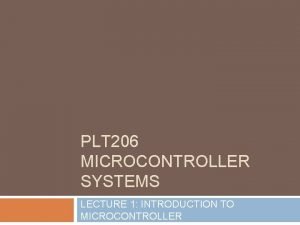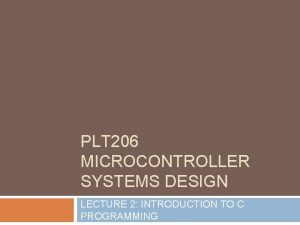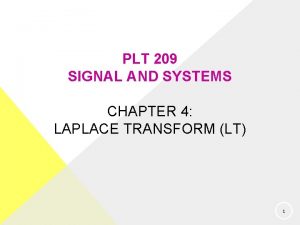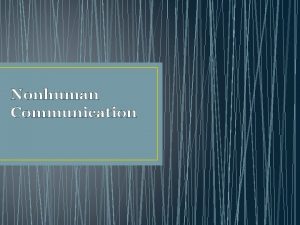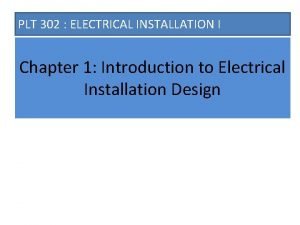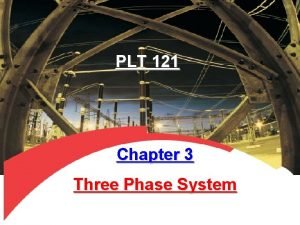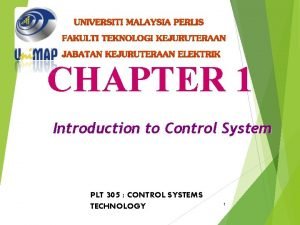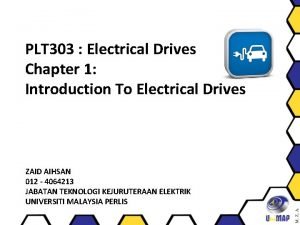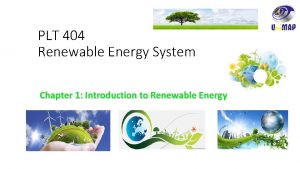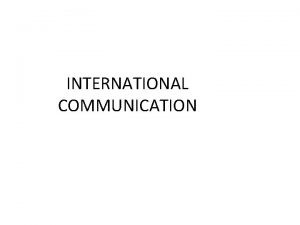PLT 208 COMMUNICATION SYSTEMS CHAPTER 1 INTRODUCTION TO






















































- Slides: 54

PLT 208 – COMMUNICATION SYSTEMS CHAPTER 1 : INTRODUCTION TO COMMUNICATION SYSTEM CHANURI A/P CHARIN

COURSE OUTCOME CO 1: Ability to distinguish the basic requirement of communication systems and the essential of communication system.

INTRODUCTION… Communications: Transfer of Information from one place to another. Ø Should be efficient, reliable, and secured. Ø Communication system: components/subsystems act together to accomplish information transfer/exchange. Ø process of conveying information from a source to a destination. Ø PLT 208 – COMMUNICATION SYSTEMS

INTRODUCTION… Electronic communication system: Ø transmission, reception and processing of information between two or more locations using electronic circuits/electric field as a mean of signal. Information source / signal: Ø Analog form Ø Ø Physical quantity varies with specified degree of fidelity Digital form Ø An ordered sequence of symbols selected from a finite set of discrete elements PLT 208 – COMMUNICATION SYSTEMS

Have you ever pictured yourself living in a world without any communication system? PLT 208 – COMMUNICATION SYSTEMS


NEED FOR COMMUNICATION… Importance of communication: Ø exchange of information between two parties separated in distances in a more faster and reliable way. PLT 208 – COMMUNICATION SYSTEMS

INFORMATION, MESSAGE AND SIGNALS… Information Ø Message Ø The commodity produced by the source for transfer to some user at the destination. The physical manifestation of information as produced by the information source. Signals Ø A physical embodiment of information – voltage signal or current signal PLT 208 – COMMUNICATION SYSTEMS

BRIEF HISTORY IN COMMUNICATION… Year 1844 1876 1904 1923 1936 1962 1966 1972 1989 Events Telegraph Telephone AM Radio Television FM Radio Satellite Optical links using laser and fiber optics Cellular Telephone Internet PLT 208 – COMMUNICATION SYSTEMS

DEVELOPMENT AND PROGRESS… Communications between human beings Form of hand gestures and facial expressions Ø Verbal grunts and groans Ø Long distance communications Smoke signals Ø Telegraph Ø Telephone Ø Wireless radio signals Triode vacuum tube Ø Commercial radio broadcasting Ø

ANALOG VS. DIGITAL… Analog Continuous Variation Ø Assume the total range of frequencies/time Ø All information is transmitted Ø Digital Ø Takes samples: § Ø non continuous stream of on/off pulses Translates to 1’s and 0’s PLT 208 – COMMUNICATION SYSTEMS

ANALOG VS. DIGITAL… Digital CS Advantages: -Inexpensive and easier to design -Privacy preserved(data encrypted) -Can merge different data -Error correction (coding) -Noise can be reduced (repeater) -Digital circuits are less affected by noise Disadvantages: -Larger bandwidth -Synchronization problem is relatively difficult PLT 208 – COMMUNICATION SYSTEMS

ANALOG VS. DIGITAL… Analog CS Disadvantages: -expensive -No privacy preserved -Cannot merge different data -No error correction capability Advantages: -smaller bandwidth -synchronization problem is relatively easier. PLT 208 – COMMUNICATION SYSTEMS

BASIC REQUIREMENTS OF COMMUNICATION SYSTEM… Rate of information transfer: Ø Purity of signal received: Ø whether the signal received is the same as the signal being transmit Simplicity of the system Ø how fast the information can be transferred the simpler the system, the better Reliability PLT 208 – COMMUNICATION SYSTEMS

ELEMENTS OF COMMUNICATION SYSTEM(CS)… Noise Interference Distortion Transmitted Signal TRANSDUCER Output Signal TRANSMITTER RECEIVER Source Transmission medium Or Communication channel TRANSDUCER Destination PLT 208 – COMMUNICATION SYSTEMS

ELEMENTS OF CS(CONT’D)… Information The communication system exists to convey a message. Ø Message comes from information source Ø Information forms - audio, video, text or data Ø Transducer Convert any type of input to an electrical signal Ø E. g. speech waves are converted to voltage variation by a microphone Ø PLT 208 – COMMUNICATION SYSTEMS

ELEMENTS OF CS(CONT’D)… Transmitter: Processes input signal to produce a transmitted signal that suited the characteristic of transmission channel. Ø E. g. modulation, coding, mixing, translate Ø Other functions performed - Amplification, filtering, antenna Ø Channel (transmission medium): a medium that bridges the distance from source to destination. Eg : Atmosphere (free space), coaxial cable, fiber optics, waveguide Ø signals undergoes degradation from noise , interference and distortion Ø PLT 208 – COMMUNICATION SYSTEMS

ELEMENTS OF CS(CONT’D)…. Receiver: to recover the message signal contained in the received signal from the output of the channel, and convert it to a form suitable for the output transducer. Ø E. g. mixing, demodulation, decoding Ø Other functions performed: Amplification, filtering. Ø Transducer: Ø Transducer converts the electrical signal at its input into a form desired by the system used PLT 208 – COMMUNICATION SYSTEMS

NOISE, INTERFERENCE AND DISTORTION… Noise unwanted signals that coincide with the desired signals. Ø Two type of noise : internal and external noise. Ø Internal Ø noise Caused by internal devices/components in the circuits. External noise that is generated outside the circuit. Ø E. g. atmospheric noise, solar noise, cosmic noise, man made noise. Ø PLT 208 – COMMUNICATION SYSTEMS

NOISE, INTERFERENCE AND DISTORTION (CONT’D)… Interference Contamination by extraneous signals from human sources. Ø E. g. from other transmitters, power lines and machineries. Ø Occurs most often in radio systems whose receiving antennas usually intercept several signals at the same time Ø One type of noise. Ø PLT 208 – COMMUNICATION SYSTEMS

NOISE, INTERFERENCE AND DISTORTION (CONT’D)… Distortion Signals or waves perturbation caused by imperfect response of the system to the desired signal itself. Ø May be corrected or reduced with the help of equalizers. Ø PLT 208 – COMMUNICATION SYSTEMS

MODULATION… What is modulation? a process of changing one or more properties of the analog carrier in proportion to the information signal. Ø One of the characteristics of the carrier signal is changed according to the variations of the modulating signal. Ø § § § AM – amplitude, E FM – frequency , ω PM - phase , θ PLT 208 – COMMUNICATION SYSTEMS

MODULATION (CONT’D)… Why modulation is needed? Ø Ø Ø To generate a modulated signal suited and compatible to the characteristics of the transmission channel. For ease radiation and reduction of antenna size Reduction of noise and interference Channel assignment Increase transmission speed PLT 208 – COMMUNICATION SYSTEMS

LIMITATIONS IN COMMUNICATION SYSTEM… Technological problems Includes equipment availability, economic factors, federal regulations and interaction with existing systems. Ø Problem solved in theory but perfect solutions may not be practical. Ø PLT 208 – COMMUNICATION SYSTEMS

LIMITATIONS IN COMMUNICATION SYSTEM (CONT’D)… Physicals limitations Ø Bandwidth limitation Ø Ø Measure of speed The system ability to follow signal variations depends on the transmission bandwidth. Available bandwidth determines the maximum signal speed. Noise limitation Ø Ø Ø Unavoidable. The kinetic theory. Noise relative to an information signal is measured in terms of signal to noise ratio (SNR). PLT 208 – COMMUNICATION SYSTEMS

COMMUNICATION SYSTEM DESIGN… Compromise within: Ø Ø Ø Transmission time and power SNR performance Cost of equipments Channel capacity Bandwidth PLT 208 – COMMUNICATION SYSTEMS

FREQUENCY AND WAVELENGTH… Cycle - One complete occurrence of a repeating wave (periodic signal) such as one positive and one negative alternation of a sine wave. Frequency - the number of cycles of a signal that occur in one second. Period - the time distance between two similar points on a periodic wave. Wavelength - the distance traveled by an electromagnetic (radio) wave during one period. PLT 208 – COMMUNICATION SYSTEMS

PERIOD AND FREQUENCY COMPARED… T = One period time One cycle Frequency = f = 1/T PLT 208 – COMMUNICATION SYSTEMS

FREQUENCY AND WAVELENGTH COMPARED + T 0 time f = 1/T distance PLT 208 – COMMUNICATION SYSTEMS

CALCULATING WAVELENGTH AND FREQUENCY… = 300/f f = 300/ = wavelength in meters f = frequency in MHz PLT 208 – COMMUNICATION SYSTEMS

THE ELECTROMAGNETIC SPECTRUM FROM 30 HZ TO 300 GHZ (f = 300/ ) 300 GHz 300 MHz 10 -4 m Millimeter waves 10 -3 m 10 -2 m 10 -1 m 1 m ( = 300/f) VHF UHF SHF EHF 30 MHz HF 3 MHz MF 10 m 102 m 103 m LF 300 k. Hz 104 m 105 m VLF 30 k. Hz VF 300 Hz 30 Hz ELF 3 k. Hz 107 m 106 m Wavelength Frequency PLT 208 – COMMUNICATION SYSTEMS

LOW AND MEDIUM FREQUENCIES… Extremely Low Frequencies (ELF)- 30 to 300 Hz Voice Frequencies (VF)- 300 to 3000 Hz Very Low Frequencies (VLF)- 3 k. Hz to 30 k. Hz Low Frequencies (LF)- 30 k. Hz to 300 k. Hz Medium Frequencies (MF) - 300 k. Hz to 3 MHz PLT 208 – COMMUNICATION SYSTEMS

HIGH FREQUENCIES… High Frequencies (HF) - 3 MHz to 30 MHz Very High Frequencies (VHF) - 30 MHz to 300 MHz Ultra High Frequencies (UHF)- 300 MHz to 3 GHz (1 GHz and above = microwaves) Super High Frequencies (SHF)- 3 GHz to 30 GHz Extremely High Frequencies (EHF)- 30 GHz to 300 GHz PLT 208 – COMMUNICATION SYSTEMS

300 GHz Cosmic rays Gamma rays X-rays Ultraviolet Visible Infrared Millimeter waves 0. 4 x 10 -6 m 0. 8 x 10 -6 m 10 -5 m 10 -4 m 10 -3 m THE ELECTROMAGNETIC SPECTRUM ABOVE 300 GHZ Wavelength PLT 208 – COMMUNICATION SYSTEMS

OPTICAL FREQUENCIES… Infrared - 0. 7 to 10 micron Visible light - 0. 4 to 0. 8 micron Ultraviolet - Shorter than 0. 4 micron Note: A micron is one millionth of a meter. Light waves are measured and expressed in wavelength rather than frequency. PLT 208 – COMMUNICATION SYSTEMS

TYPES OF COMMUNICATIONS… TX Channel TX RX RX Channel(s) RX TX Simplex: One-way Duplex: Two-way Half duplex: Alternate TX/RX Full duplex: Simultaneous TX/RX PLT 208 – COMMUNICATION SYSTEMS

COMMUNICATIONS SIGNAL VARIATIONS… Baseband - The original information signal such as audio, video, or computer data. Can be analog or digital. Broadband - The baseband signal modulates or modifies a carrier signal, which is usually a sine wave at a frequency much higher than the baseband signal. PLT 208 – COMMUNICATION SYSTEMS

VARIOUS FORMS OF COMMUNICATION SYSTEM… Broadcast: radio and television Mobile communications Fixed communication system- land line Data communication-internet PLT 208 – COMMUNICATION SYSTEMS

FREQUENCY SPECTRUM &BANDWIDTH… The frequency spectrum of a waveform consists of all frequencies contained in the waveform and their amplitudes plotted in the frequency domain. The bandwidth of a frequency spectrum is the range of frequencies contained in the spectrum. It is calculated by subtracting the lowest frequency from the highest. PLT 208 – COMMUNICATION SYSTEMS

FREQUENCY SPECTRUM &BANDWIDTH(CONT’D)… Bandwidth of the information signal equals to the difference between the highest and lowest frequency contained in the signal. Similarly, bandwidth of communication channel is the difference between the highest and lowest frequency that the channel allow to pass through it PLT 208 – COMMUNICATION SYSTEMS

“It took a hundred years to connect a billion by wire. It has taken only ten years to connect the next billion people” - National Geographic Magazine, December 2001 - PLT 208 – COMMUNICATION SYSTEMS

PLT 208 – COMMUNICATION SYSTEMS GAIN, ATTENUATION AND DECIBELS

GAIN… Gain – amplification Ratio of the output to the input Two types: � Signal gain � Power gain Amplifier Vin Vout Input Signal Output Signal A = gain PLT 208 – COMMUNICATION SYSTEMS

SIGNAL GAIN In Engineering Problems, we have known the term signal gain / mechanical advantage; Examples: � Voltage amplifier: output voltage/input voltage. � Transistors current gain: = ic/ib, � Chain pulley block: weight lifted/weight applied. � Transformer: secondary voltage/primary voltage � Gear box: output torque/input torque. Voltage gain Av: signal gain may be >1 PLT 208 – COMMUNICATION SYSTEMS

POWER GAIN Power gain Ap: If the energy is consumed in doing a work, Power gain is always 1. Example : transformer, chain pulley block, gear boxes etc have power gain less than one. In amplifiers, the apparent power gain may be more than one. The signal power is amplified. DC electric power is transformed into signal power. PLT 208 – COMMUNICATION SYSTEMS

EXAMPLES… 1. What is the voltage gain of an amplifier that produces an output of 750 m. V for a 30µV input? 2. The power output of an amplifier is 6 watts(W). The power gain is 80. what is the input power? 3. Three cascaded amplifiers have power gain of 5, 2, and 17. the input power is 40 m. W. What is the output power? PLT 208 – COMMUNICATION SYSTEMS

ATTENUATION… Attenuation – loss by circuit/component. If the output signal is lower in amplitude than the input, the circuit has loss or attenuation. Ratio of the output to the input. Letter A is used to represent attenuation (like gain) PLT 208 – COMMUNICATION SYSTEMS

POWER AND VOLTAGE GAIN IN COMMUNICATION In communication, due to known characteristic impedance of the channel, the power and voltage gains become explicit. It is designated in terms of decibels, d. B. Power gain in d. B : Voltage gain in d. B: When the circuit has gain, the decibel is positive. If the gain < 1, which means that there is attenuation, the decibel is negative. PLT 208 – COMMUNICATION SYSTEMS

EXAMPLES: power ratio Po/Pi = 10, 000, Power in d. B = 10 log (10, 000) = 40 d. B Voltage ratio Vo/Vi = 100, Voltage in d. B = 20 log (100) =40 d. B. See that Po/Pi = (Vo/Vi)2 (Po/Pi) d. B = 2(Vo/Vi) d. B PLT 208 – COMMUNICATION SYSTEMS

EXAMPLES: 1. An amplifier has an input of 3 m. V and an output of 5 V. What is the gain in decibels? 2. A filter has a power input of 50 m. W and an output of 2 m. W. What is the gain or attenuation? PLT 208 – COMMUNICATION SYSTEMS

ALTERNATIVELY: Power gain = 10 (gain in d. B/10) Voltage gain = 10 (gain in d. B/20) Examples: A 64 d. B gain means 106. 4 = 2. 5212 x 106 watts. An attenuation by 0. 01= 10 log(0. 01) = -20 d. B PLT 208 – COMMUNICATION SYSTEMS

EXAMPLES: Let there be two amplifiers in cascade. Their gains are 13 d. B and 10 d. B respectively. The overall gain is 13+10 = 23 d. B. In terms of ratio: 23 d. B = 10(23/10)= 200 13 d. B = 10(13/10)= 20 10 d. B = 10(10/10)= 10 Again 20 x 10 = 200. PLT 208 – COMMUNICATION SYSTEMS

RELATIVE DB It is convenient to express signals with some reference such as 1 m. W power or, 1 V voltage level. This permits input- and output- signals to be expressed in terms of relative d. B. When referenced to 1 m. W, it is written as d. Bm When referenced to 1 V, it is written as d. B V PLT 208 – COMMUNICATION SYSTEMS

RELATIVE DB IS NOT A GAIN BUT IS TERMED AS GAIN WRT A REFERENCE. 5 watts signal, In relative d. B; 10 log(5 W/1 m. W) = 36. 99 d. Bm 500 V signal: In relative d. B; 20 log(500 V /1 V ) = 53. 98 d. B V PLT 208 – COMMUNICATION SYSTEMS
 Ics 208
Ics 208 Ana 208
Ana 208 Me gustan me encantan (p. 135)
Me gustan me encantan (p. 135) Pl 107-208
Pl 107-208 Xkcd regexp
Xkcd regexp Level 2 pp. 208-210 answers
Level 2 pp. 208-210 answers Memory express
Memory express 136xe isotope
136xe isotope What is standard notation
What is standard notation Huesos con l
Huesos con l Nine section perm
Nine section perm 277/480 transformer bank
277/480 transformer bank Chapter 18 plastic laminates
Chapter 18 plastic laminates 208 rmb
208 rmb Comp 208
Comp 208 208 huesos
208 huesos Pa 208
Pa 208 Dns 208 67 222 222
Dns 208 67 222 222 Lymphl
Lymphl Sysmex xe2100
Sysmex xe2100 Micro hydro power
Micro hydro power Distribuzione volumetrica plt
Distribuzione volumetrica plt Plt scheme
Plt scheme Fuzzification
Fuzzification Plt electronics
Plt electronics Plt 106
Plt 106 Extra high voltage
Extra high voltage Fcps my plt
Fcps my plt Plt cbc
Plt cbc Plt information session
Plt information session คืออะไร
คืออะไร Plt morphology
Plt morphology Import numpy as np import matplotlib.pyplot as plt
Import numpy as np import matplotlib.pyplot as plt Anu plt
Anu plt Labo
Labo How to draw an ye
How to draw an ye Billy b and plt
Billy b and plt Independent enquirer
Independent enquirer Plt skills
Plt skills Kewenangan plt dan plh dalam aspek keuangan
Kewenangan plt dan plh dalam aspek keuangan Fibrinolitikler
Fibrinolitikler Chapter 3 lesson 1 introduction to global systems
Chapter 3 lesson 1 introduction to global systems Ems systems chapter 1
Ems systems chapter 1 Decision support systems and intelligent systems
Decision support systems and intelligent systems Engineering elegant systems: theory of systems engineering
Engineering elegant systems: theory of systems engineering Embedded systems vs cyber physical systems
Embedded systems vs cyber physical systems Engineering elegant systems: theory of systems engineering
Engineering elegant systems: theory of systems engineering Principles of electronic communication systems 3rd edition
Principles of electronic communication systems 3rd edition Iec 61850 communication networks and systems in substations
Iec 61850 communication networks and systems in substations Communication technology quiz
Communication technology quiz Business communication systems
Business communication systems Modeling of digital communication systems using simulink
Modeling of digital communication systems using simulink Characteristics of interprocess communication
Characteristics of interprocess communication Communication theory of secrecy systems
Communication theory of secrecy systems Analog vs digital communication systems
Analog vs digital communication systems
